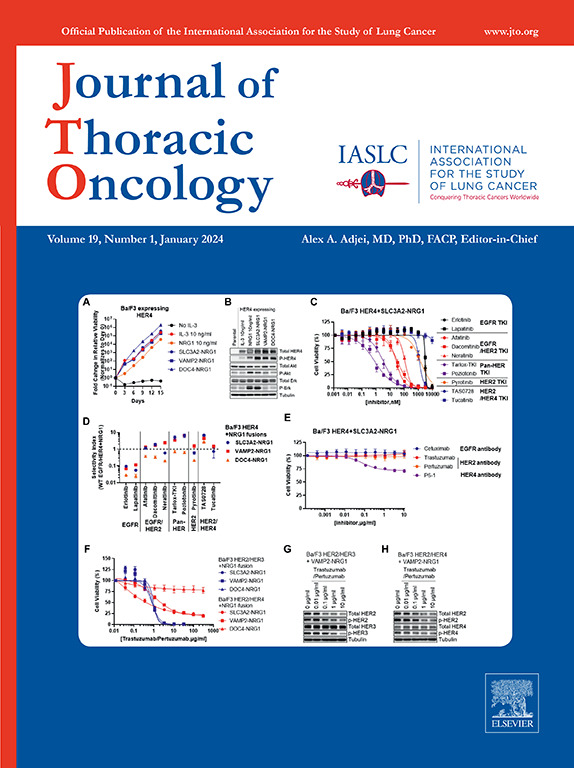Durvalumab与化疗作为肿瘤PD-L1表达≥25%的转移性NSCLC的一线治疗:随机 3 期 PEARL 研究结果。
IF 21
1区 医学
Q1 ONCOLOGY
引用次数: 0
摘要
研究简介PEARL(NCT03003962)是一项开放标签的3期研究,比较了PD-L1肿瘤细胞(TC)膜表达状态≥25%的转移性非小细胞肺癌(mNSCLC [表皮生长因子受体/ALK野生型])患者一线使用durvalumab单药与化疗的效果。我们报告了 PEARL 的最终分析结果:既往未经治疗的 IV 期 mNSCLC 成人患者(N=669)被随机(1:1)分配到每 4 周一次的 durvalumab 20mg/kg 或每 3 周一次的化疗,共 4 到 6 个周期。双重主要终点是PD-L1 TC≥25%人群和PD-L1 TC≥25%低早期死亡风险(LREM)人群的总生存期(OS):在PD-L1 TC≥25%的人群中,Durvalumab与化疗相比可降低死亡风险(OS危险比[HR]0.84,95%置信区间[CI]0.71,0.99,P = 0.037;中位OS分别为14.6个月[95% CI:12.2,16.9]和12.8个月[95% CI:10.1,14.7])。在PD-L1 TC≥25% LREM人群中,durvalumab与化疗相比的OS HR为0.96(95% CI:0.79,1.15,p = 0.628);中位OS分别为14.6个月(95% CI:12.6,17.2)与15.0个月(95% CI:13.1,16.8)。在安全性研究人群中,3/4级治疗相关不良事件的发生率为15.5%(杜伐单抗)和45.9%(化疗):结论:对于PD-L1 TC≥25%的mNSCLC一线治疗患者,与化疗相比,Durvalumab在统计学上并未显著改善患者的OS。OS的数值改善与之前对mNSCLC患者进行的一线免疫检查点抑制剂单药治疗研究结果一致。本文章由计算机程序翻译,如有差异,请以英文原文为准。
Durvalumab Versus Chemotherapy as First-line Treatment for Metastatic NSCLC With Tumor PD-L1 Expression of 25% or Higher: Results From the Randomized Phase 3 PEARL Study
Introduction
PEARL (NCT03003962) is an open-label, phase 3 study comparing first-line durvalumab monotherapy with chemotherapy in patients with metastatic NSCLC (mNSCLC [EGFR/ALK wild type]) with programmed cell death ligand 1 (PD-L1) tumor cell (TC) membrane expression status of 25% or higher. We report the final analysis of PEARL.
Methods
Adults (N = 669) with previously untreated stage IV mNSCLC were randomized (1:1) to durvalumab 20 mg/kg every four weeks or chemotherapy every three weeks for four to six cycles. The dual primary endpoints were overall survival (OS) in the population with PD-L1 TC of 25% or higher and OS in the population at low risk of early mortality (LREM) with PD-L1 TC of 25% or higher.
Results
Durvalumab was associated with a numerical reduction in the risk of death versus chemotherapy in the 25% and higher PD-L1 TC population (OS hazard ratio [HR] = 0.84, 95% confidence interval [CI]: 0.71–0.99, p = 0.037; median OS 14.6 months, 95% CI: 12.2–16.9 versus 12.8 months, 95% CI: 10.1–14.7, respectively). In the 25% and higher PD-L1 TC low risk of early mortality population the OS hazard ratio for durvalumab versus chemotherapy was 0.96 (95% CI: 0.79–1.15, p = 0.628); median OS 14.6 months (95% CI: 12.6–17.2) versus 15.0 months (95% CI: 13.1–16.8), respectively. In the safety population, the incidence of grade 3 or 4 treatment-related adverse events was 15.5% (durvalumab) and 45.9% (chemotherapy).
Conclusions
Durvalumab did not statistically significantly improve OS versus chemotherapy as first-line treatment in patients with mNSCLC and 25% and higher PD-L1 TC. The numerical improvement in OS was consistent with previous studies of first-line immune checkpoint inhibitor monotherapy in patients with mNSCLC.
求助全文
通过发布文献求助,成功后即可免费获取论文全文。
去求助
来源期刊

Journal of Thoracic Oncology
医学-呼吸系统
CiteScore
36.00
自引率
3.90%
发文量
1406
审稿时长
13 days
期刊介绍:
Journal of Thoracic Oncology (JTO), the official journal of the International Association for the Study of Lung Cancer,is the primary educational and informational publication for topics relevant to the prevention, detection, diagnosis, and treatment of all thoracic malignancies.The readship includes epidemiologists, medical oncologists, radiation oncologists, thoracic surgeons, pulmonologists, radiologists, pathologists, nuclear medicine physicians, and research scientists with a special interest in thoracic oncology.
 求助内容:
求助内容: 应助结果提醒方式:
应助结果提醒方式:


